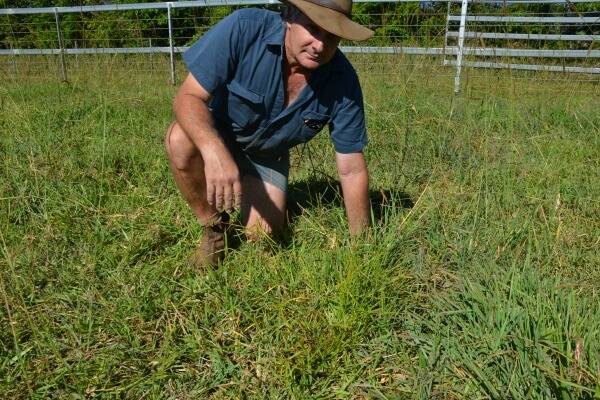
HALLOWEEN may have been and gone but Navua Sedge is guaranteed to stay and become a producer’s worst nightmare if immediate action is not taken.
Originally native to tropical Africa, Navua Sedge (Cyperus aromaticus) has been a problem in Queensland as early as 1959 and has since spread north to the Daintree - Mossman area, south to Ingham and west across the wetter areas of the Atherton Tablelands.
Navua Sedge is a vigorous grass-like, perennial sedge which grows to 30-70 cm in height but may occasionally reach 2 metres.
It is extremely aggressive and is capable of forming dense stands that can smother many tropical pasture species.
Navua Sedge is unpalatable and provides little feed value for cattle and if pastures are heavily or overgrazed Navau Sedge can quickly take over.
Spread occurs through the normal extension of the rhizome system, by seed and by dispersal of viable rhizome fragments during cultivation.
The seeds can germinate at any time of the year and the seed heads on each shoot generally produce about 250 seeds each.
Seed production per hectare is extremely high with estimates well in excess of 200 million seeds.
Seed is viable for five years, so producers can have five years of trouble ahead of them if plants mature and produce viable seed.
The dispersal of seed can occur through many ways such as by passing through the digestive system of animals and birds, and also by being transported in mud on hooves, footwear, flood or running water or machinery and/or vehicles.
Seedlings develop quickly from seed and flower in just 10 weeks after emergence.
It is without doubt that Navua Sedge is a horror weed which will have a devastating impact on the Tablelands hay and grazing industries if immediate action is not taken.
“This is the worst pasture weed ever that we have encountered on the wet coast Tablelands,” DAFF Senior Beef Extension Officer Bernie English said.
“It is extremely invasive.
Road sides all over the district are full of it.
The Malanda Beef Plan Group have had a ‘gut full’ of it and want to get some co-ordination across the district to attack this weed.”
The Malanda Beef Plan Group has coordinated a series of meetings with the Tablelands Regional Council (TRC).
The group sincerely appreciates the efforts of Councillors Peter Hodge and Shaaron Linwood who have enabled a series of meetings to be conducted between Beef Plan members and TRC weed officers to discuss the way ahead.
“Local government and the producers have to work together,” said Bernie.
“There needs to be coordination across all groups in the district which include local government, all producers, as well as contractors that access properties.These include Ergon, fertilising contractors, back hoes and bull dozers etc. This is the objective of the Malanda Beef Plan Group.”
There is currently no registered selective herbicide available for Navua Sedge, however work is continuing on the herbicide Sempra. It is possible that it could be registered at some point in 2014 and is currently being used at the landholder’s own risk.
It is really important for all producers to be able to recognise the weed.
Producers must be prepared to do their bit and be vigilant and monitor their properties. They need to monitor roadsides and be prepared to spray. Roadside drains can easily divert water containing Navua Sedge seeds onto properties.
Machinery such as slashers can readily spread seed to other areas so it is important to ensure that all vehicles and machinery are thoroughly washed down before moving from one infested area to a clean one.
Not overgrazing and managing pastures well to ensure that you maintain good ground cover is critical in minimising possible Navua Sedge invasion.

